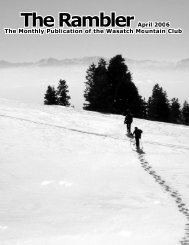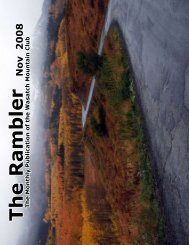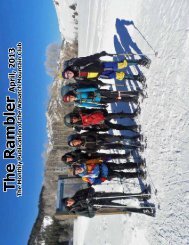Rambler
September 2010 - Wasatch Mountain Club
September 2010 - Wasatch Mountain Club
- No tags were found...
Create successful ePaper yourself
Turn your PDF publications into a flip-book with our unique Google optimized e-Paper software.
Figure 3. This 1907 map shows the road between Brighton<br />
and the Mountain Lake mine. The map was made before the<br />
road was continued up to the Emperor tunnel. The names of<br />
the two mines are reversed, an error that was carried on to<br />
the later 1939 edition of the map.<br />
company’s tunnel he also continued prospecting, alone and<br />
with various other parties. In the spring of 1899 he gained the<br />
support of Utah Senator Joseph L. Rawlins and filed a series<br />
of claims to the east of Brighton. On the basis of those claims<br />
the Great Western Gold & Copper Mining Company was<br />
incorporated in October of 1900; Rawlins was the principal<br />
stockholder with Robert Brighton in a distant second place. It<br />
didn’t take long before Jesse Knight, the mining promoter<br />
from Provo, bought a giant’s share of the company’s stock,<br />
including Brighton’s, and then Rawlins and Knight bought<br />
Brighton’s interest in the Mountain Lake Mining Company.<br />
The Mountain Lake and Great Western properties were<br />
worked independently for some time until Knight gained<br />
control of the Steamboat Tunnel in Snake Creek Canyon. That<br />
was extended to get under the Mountain Lake properties at<br />
great depth and the surface work in Big Cottonwood was<br />
phased out. However it is likely the Mountain Lake tunnel was<br />
worked by leasers in later years, at least to the mid-twentieth<br />
century.<br />
The Big Cottonwood Copper & Gold Mining Company,<br />
formed in March 1900, also made use of the Mountain Lake<br />
road. This company held two claims adjacent to the Mountain<br />
Lake company’s properties. The Leggett claim was mentioned<br />
in a recent Faint Trails article relative to the establishment of<br />
U.S. Mineral Monument No.6. The company worked this<br />
claim through a tunnel located only a short distance southeast<br />
of the Mountain Lake company’s mine. The other claim was<br />
the Relief, which overlapped the Leggett and ran over the<br />
divide into the Snake Creek drainage. In its early days it was<br />
worked through a shaft located on the divide, east of Pioneer<br />
Peak. Anyone who has done a ridge run heading east from<br />
Sunset and Pioneer Peaks will remember passing the remnants<br />
of this shaft, with its great amount of blue-green rock and a<br />
road coming up from Snake Creek canyon. The Big<br />
Cottonwood Copper company belonged to Col. Nicholas<br />
Treweek, a well known mining promoter at the turn of the<br />
twentieth century. He pushed work on the tunnel with great<br />
enthusiasm for a number of years, but as the demands of other<br />
investments claimed his time and resources, the emphasis<br />
placed on these mines diminished. After he died unexpectedly following an operation in 1914 nothing more was<br />
reported about his Big Cottonwood company.<br />
The Emperor tunnel was a venture of Henry Andrew<br />
Gebhardt, a Salt Lake City baker and mining promoter.<br />
He was a partner with Thomas Kearns in the Emperor<br />
Consolidated Mining Company in Snake Creek, then filed<br />
a number of claims on the ridge south of the Dog Lake<br />
basin where he started a tunnel on the Emperor claim.<br />
After his death in 1915 his three sons formed the<br />
Emperor Mining Company and continued driving the<br />
tunnel and drifts to a total length of about 700 feet by the<br />
1940 decade, when their operations were abandoned.<br />
Today the road to these mines still exists, part of it<br />
having been used to access the upper portions of the ski<br />
area. Little remains at the various sites, save the remnants<br />
of an ore bin and large log building at the Big<br />
Cottonwood mine, and the dumps at all three tunnels. A<br />
foundation and metallic pieces of a structure at the lowest<br />
tunnel give a mute suggestion that this mine was worked<br />
by leasers in later days.<br />
. . . . . . . Faint Trails by Charles L. Keller . . . . . . .<br />
Figure 4. View looking down the slope to the Mountain Lake<br />
mine. The mine road runs above the large stone outcrop and<br />
horizontally across the picture. Dog Lake is visible left of center.<br />
33
















